Econ 3803 - Resource Economics: Scarcity, Deforestation and Solutions
VerifiedAdded on 2023/06/15
|10
|1473
|424
Homework Assignment
AI Summary
This assignment solution provides a comprehensive overview of natural resource economics, differentiating between renewable and non-renewable resources and discussing the ongoing debate about resource scarcity. It addresses deforestation, its implications, and the concept of optimal deforestation rates. The solution explores the challenges of resource use, including environmental impact, social concerns, and sustainability. It examines the role of technological progress in optimizing resource use and introduces key concepts like sustainability, intergenerational equity, static efficiency, and dynamic efficiency. The assignment also discusses valid and invalid objections to using prices to manage resource shortages and analyzes the impact of discount rates on long-term environmental strategies. Finally, it includes a case study of a wood-pulp firm, analyzing profit maximization and social net benefit in the context of external costs. Desklib provides access to this and other solved assignments for students.
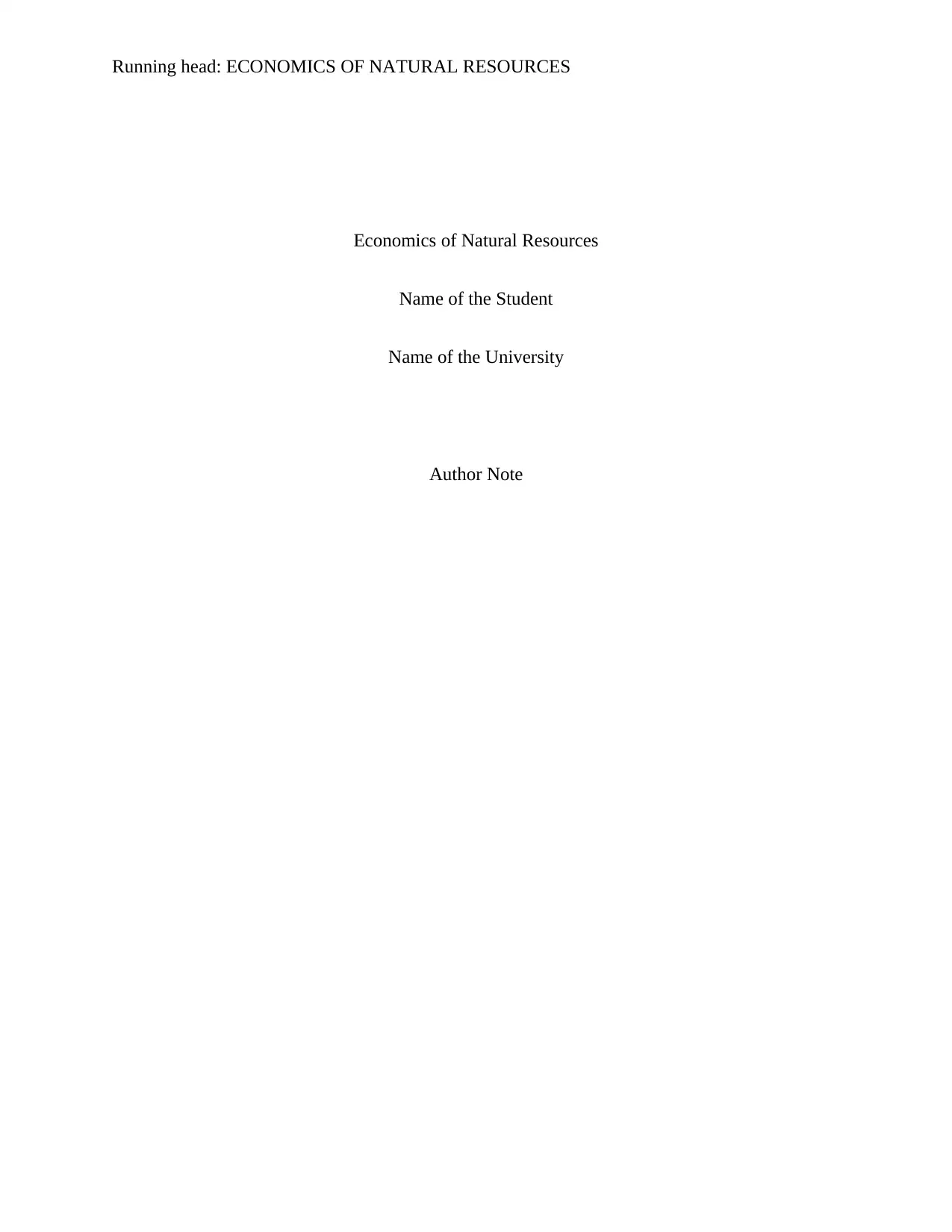
Running head: ECONOMICS OF NATURAL RESOURCES
Economics of Natural Resources
Name of the Student
Name of the University
Author Note
Economics of Natural Resources
Name of the Student
Name of the University
Author Note
Paraphrase This Document
Need a fresh take? Get an instant paraphrase of this document with our AI Paraphraser
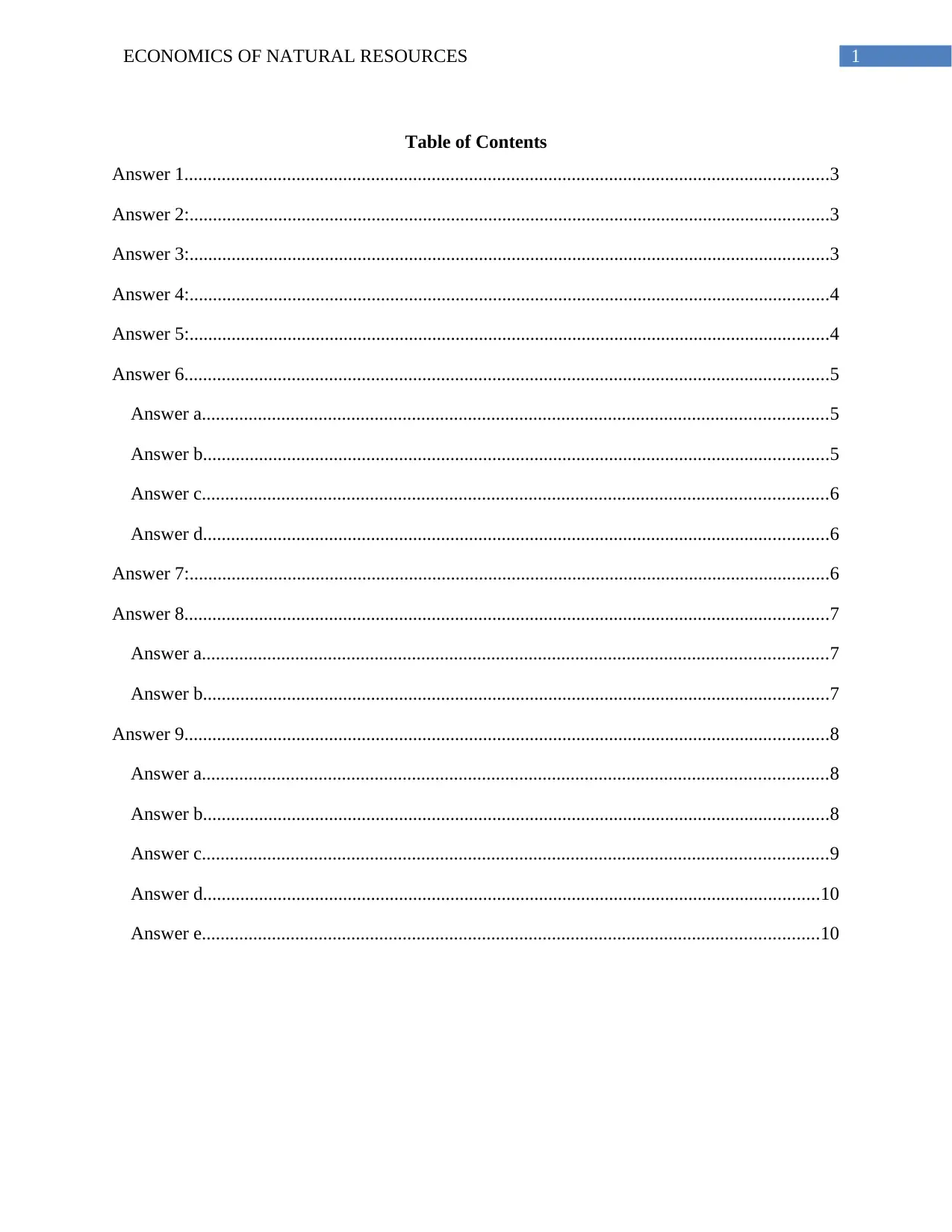
1ECONOMICS OF NATURAL RESOURCES
Table of Contents
Answer 1..........................................................................................................................................3
Answer 2:.........................................................................................................................................3
Answer 3:.........................................................................................................................................3
Answer 4:.........................................................................................................................................4
Answer 5:.........................................................................................................................................4
Answer 6..........................................................................................................................................5
Answer a......................................................................................................................................5
Answer b......................................................................................................................................5
Answer c......................................................................................................................................6
Answer d......................................................................................................................................6
Answer 7:.........................................................................................................................................6
Answer 8..........................................................................................................................................7
Answer a......................................................................................................................................7
Answer b......................................................................................................................................7
Answer 9..........................................................................................................................................8
Answer a......................................................................................................................................8
Answer b......................................................................................................................................8
Answer c......................................................................................................................................9
Answer d....................................................................................................................................10
Answer e....................................................................................................................................10
Table of Contents
Answer 1..........................................................................................................................................3
Answer 2:.........................................................................................................................................3
Answer 3:.........................................................................................................................................3
Answer 4:.........................................................................................................................................4
Answer 5:.........................................................................................................................................4
Answer 6..........................................................................................................................................5
Answer a......................................................................................................................................5
Answer b......................................................................................................................................5
Answer c......................................................................................................................................6
Answer d......................................................................................................................................6
Answer 7:.........................................................................................................................................6
Answer 8..........................................................................................................................................7
Answer a......................................................................................................................................7
Answer b......................................................................................................................................7
Answer 9..........................................................................................................................................8
Answer a......................................................................................................................................8
Answer b......................................................................................................................................8
Answer c......................................................................................................................................9
Answer d....................................................................................................................................10
Answer e....................................................................................................................................10

2ECONOMICS OF NATURAL RESOURCES
Answer 1
Natural resources are of two types- renewable resources and non-renewable resources.
The non-renewable natural resources are those available in limited supply and cannot be renewed
or takes very long time to replenish. Examples of non-renewable resources include coal, oil,
natural gas and nuclear. Renewable resources on the other hand are those available with
unlimited supply. For example, solar energy, water, wind, biomass and other.
Answer 2:
In terms of economics, resources are the key factors, which are required to produce any
good or service. These resources include natural resources also. The natural resources, which are
used in the production of goods and services, are mostly non-renewable. While the classical
economists have the belief that the usage of the limited natural resources are making them
increasingly scare with time, the neo-classical economists are optimistic regarding their
availability. According to them, when a resource gets scarce, its price increases, which leads to
substitution of the same with alternative resources or implementation of innovative technologies
for optimum usage of the same. For example, coal being a non-renewable energy resource, the
contemporary world is moving towards substitution of coal with other renewable man-made
energy resources.
Answer 3:
Deforestation is one of the environmental issues of concern as over the years this
phenomenon has increased considerably due to increase in the population and the following
economic and industrial activities. Deforestation, though is an environmental evil, often becomes
Answer 1
Natural resources are of two types- renewable resources and non-renewable resources.
The non-renewable natural resources are those available in limited supply and cannot be renewed
or takes very long time to replenish. Examples of non-renewable resources include coal, oil,
natural gas and nuclear. Renewable resources on the other hand are those available with
unlimited supply. For example, solar energy, water, wind, biomass and other.
Answer 2:
In terms of economics, resources are the key factors, which are required to produce any
good or service. These resources include natural resources also. The natural resources, which are
used in the production of goods and services, are mostly non-renewable. While the classical
economists have the belief that the usage of the limited natural resources are making them
increasingly scare with time, the neo-classical economists are optimistic regarding their
availability. According to them, when a resource gets scarce, its price increases, which leads to
substitution of the same with alternative resources or implementation of innovative technologies
for optimum usage of the same. For example, coal being a non-renewable energy resource, the
contemporary world is moving towards substitution of coal with other renewable man-made
energy resources.
Answer 3:
Deforestation is one of the environmental issues of concern as over the years this
phenomenon has increased considerably due to increase in the population and the following
economic and industrial activities. Deforestation, though is an environmental evil, often becomes
⊘ This is a preview!⊘
Do you want full access?
Subscribe today to unlock all pages.

Trusted by 1+ million students worldwide
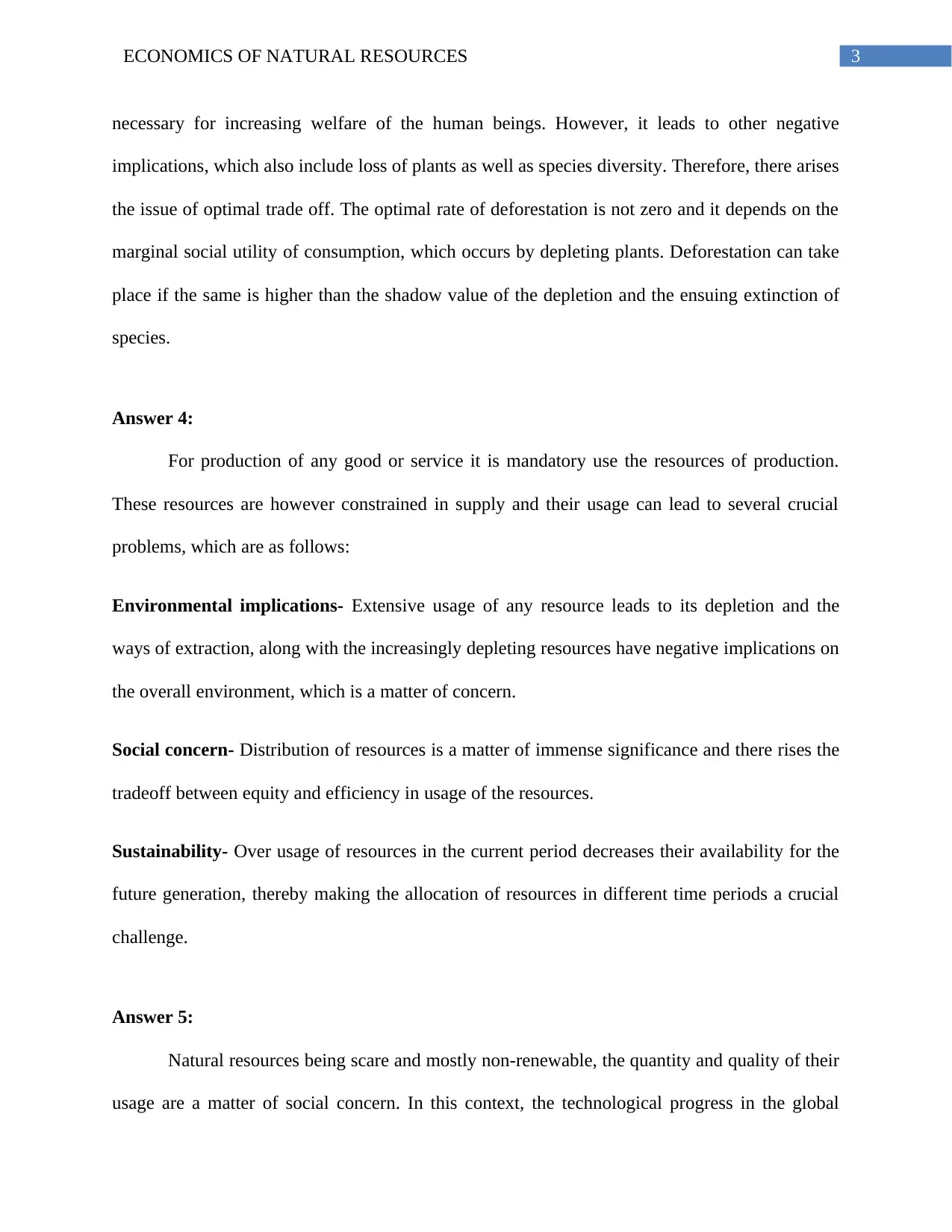
3ECONOMICS OF NATURAL RESOURCES
necessary for increasing welfare of the human beings. However, it leads to other negative
implications, which also include loss of plants as well as species diversity. Therefore, there arises
the issue of optimal trade off. The optimal rate of deforestation is not zero and it depends on the
marginal social utility of consumption, which occurs by depleting plants. Deforestation can take
place if the same is higher than the shadow value of the depletion and the ensuing extinction of
species.
Answer 4:
For production of any good or service it is mandatory use the resources of production.
These resources are however constrained in supply and their usage can lead to several crucial
problems, which are as follows:
Environmental implications- Extensive usage of any resource leads to its depletion and the
ways of extraction, along with the increasingly depleting resources have negative implications on
the overall environment, which is a matter of concern.
Social concern- Distribution of resources is a matter of immense significance and there rises the
tradeoff between equity and efficiency in usage of the resources.
Sustainability- Over usage of resources in the current period decreases their availability for the
future generation, thereby making the allocation of resources in different time periods a crucial
challenge.
Answer 5:
Natural resources being scare and mostly non-renewable, the quantity and quality of their
usage are a matter of social concern. In this context, the technological progress in the global
necessary for increasing welfare of the human beings. However, it leads to other negative
implications, which also include loss of plants as well as species diversity. Therefore, there arises
the issue of optimal trade off. The optimal rate of deforestation is not zero and it depends on the
marginal social utility of consumption, which occurs by depleting plants. Deforestation can take
place if the same is higher than the shadow value of the depletion and the ensuing extinction of
species.
Answer 4:
For production of any good or service it is mandatory use the resources of production.
These resources are however constrained in supply and their usage can lead to several crucial
problems, which are as follows:
Environmental implications- Extensive usage of any resource leads to its depletion and the
ways of extraction, along with the increasingly depleting resources have negative implications on
the overall environment, which is a matter of concern.
Social concern- Distribution of resources is a matter of immense significance and there rises the
tradeoff between equity and efficiency in usage of the resources.
Sustainability- Over usage of resources in the current period decreases their availability for the
future generation, thereby making the allocation of resources in different time periods a crucial
challenge.
Answer 5:
Natural resources being scare and mostly non-renewable, the quantity and quality of their
usage are a matter of social concern. In this context, the technological progress in the global
Paraphrase This Document
Need a fresh take? Get an instant paraphrase of this document with our AI Paraphraser
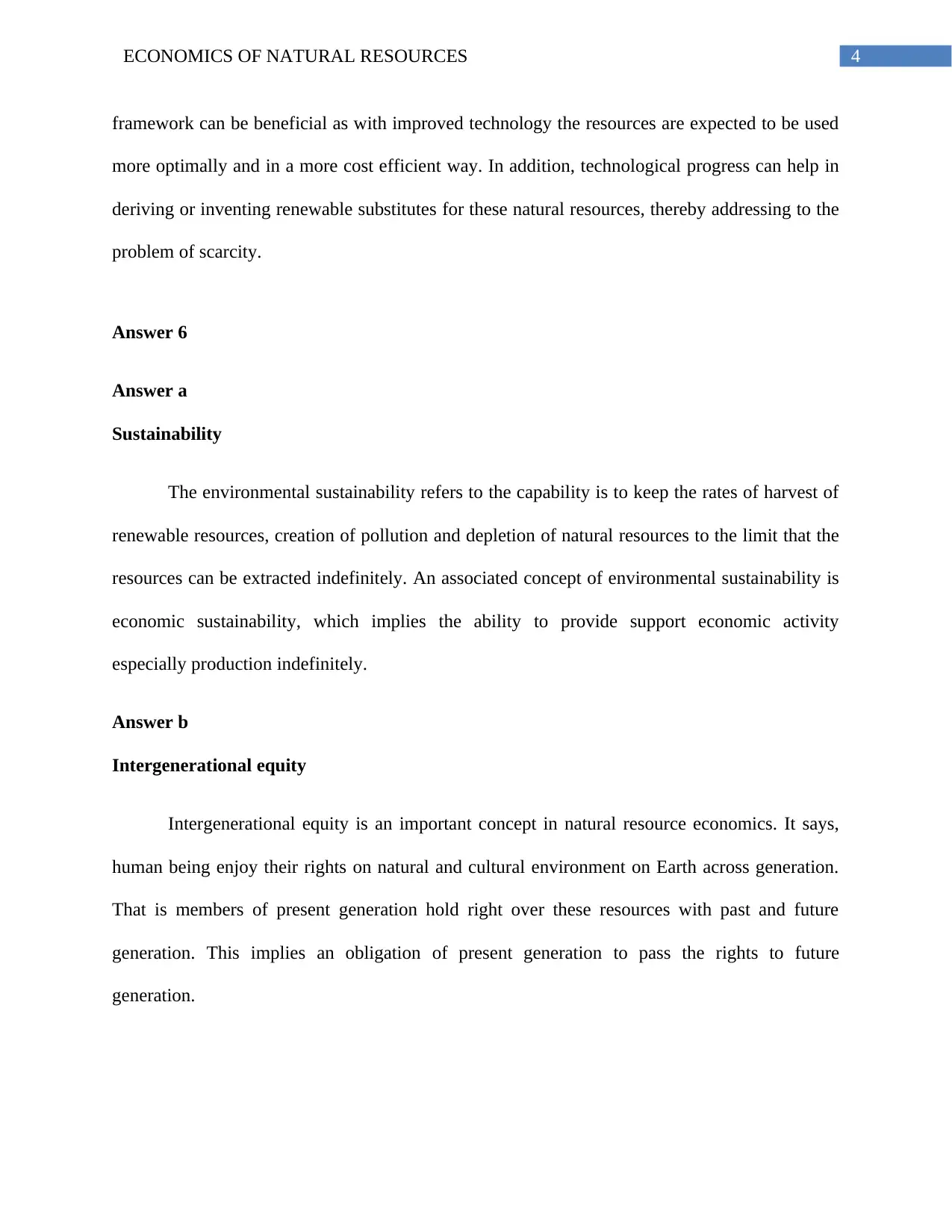
4ECONOMICS OF NATURAL RESOURCES
framework can be beneficial as with improved technology the resources are expected to be used
more optimally and in a more cost efficient way. In addition, technological progress can help in
deriving or inventing renewable substitutes for these natural resources, thereby addressing to the
problem of scarcity.
Answer 6
Answer a
Sustainability
The environmental sustainability refers to the capability is to keep the rates of harvest of
renewable resources, creation of pollution and depletion of natural resources to the limit that the
resources can be extracted indefinitely. An associated concept of environmental sustainability is
economic sustainability, which implies the ability to provide support economic activity
especially production indefinitely.
Answer b
Intergenerational equity
Intergenerational equity is an important concept in natural resource economics. It says,
human being enjoy their rights on natural and cultural environment on Earth across generation.
That is members of present generation hold right over these resources with past and future
generation. This implies an obligation of present generation to pass the rights to future
generation.
framework can be beneficial as with improved technology the resources are expected to be used
more optimally and in a more cost efficient way. In addition, technological progress can help in
deriving or inventing renewable substitutes for these natural resources, thereby addressing to the
problem of scarcity.
Answer 6
Answer a
Sustainability
The environmental sustainability refers to the capability is to keep the rates of harvest of
renewable resources, creation of pollution and depletion of natural resources to the limit that the
resources can be extracted indefinitely. An associated concept of environmental sustainability is
economic sustainability, which implies the ability to provide support economic activity
especially production indefinitely.
Answer b
Intergenerational equity
Intergenerational equity is an important concept in natural resource economics. It says,
human being enjoy their rights on natural and cultural environment on Earth across generation.
That is members of present generation hold right over these resources with past and future
generation. This implies an obligation of present generation to pass the rights to future
generation.
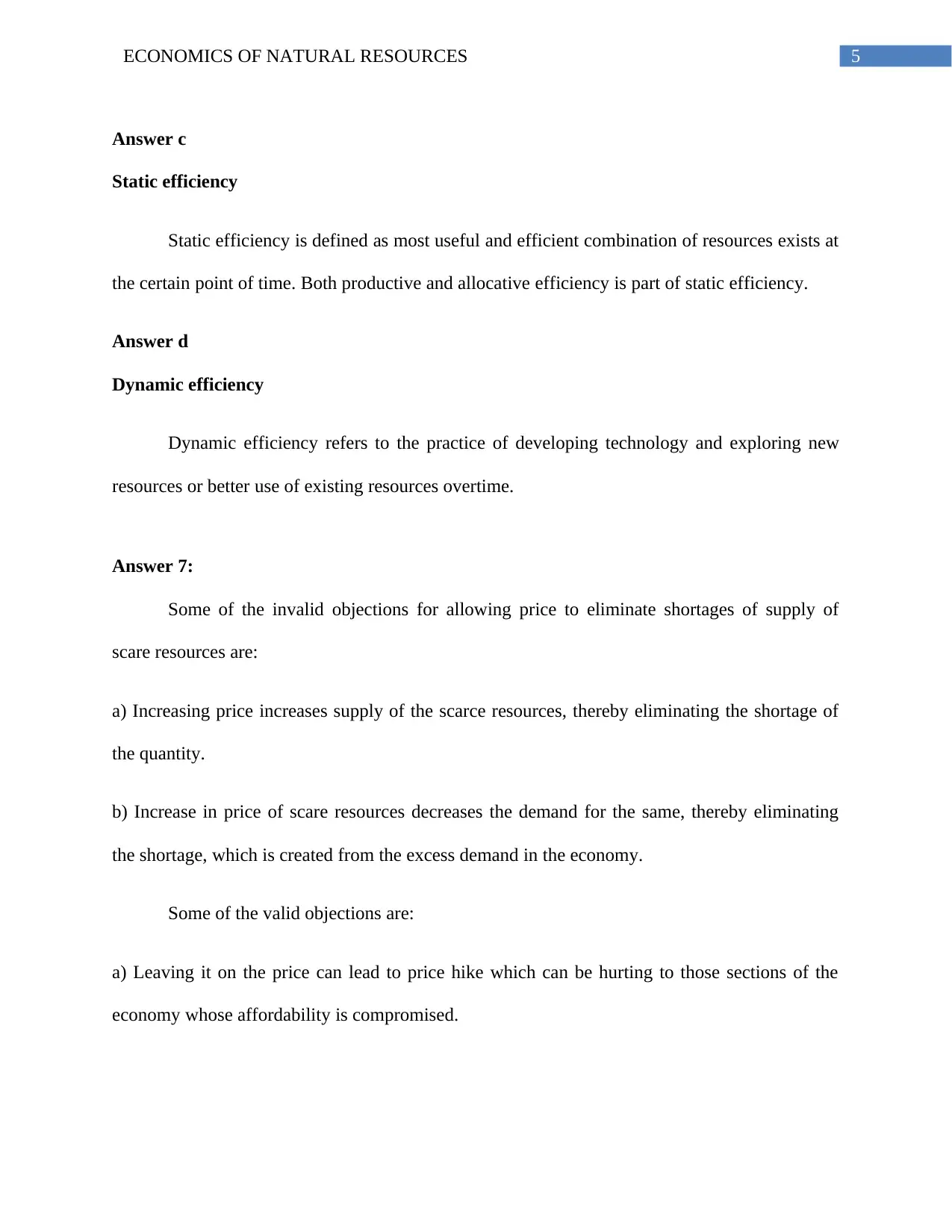
5ECONOMICS OF NATURAL RESOURCES
Answer c
Static efficiency
Static efficiency is defined as most useful and efficient combination of resources exists at
the certain point of time. Both productive and allocative efficiency is part of static efficiency.
Answer d
Dynamic efficiency
Dynamic efficiency refers to the practice of developing technology and exploring new
resources or better use of existing resources overtime.
Answer 7:
Some of the invalid objections for allowing price to eliminate shortages of supply of
scare resources are:
a) Increasing price increases supply of the scarce resources, thereby eliminating the shortage of
the quantity.
b) Increase in price of scare resources decreases the demand for the same, thereby eliminating
the shortage, which is created from the excess demand in the economy.
Some of the valid objections are:
a) Leaving it on the price can lead to price hike which can be hurting to those sections of the
economy whose affordability is compromised.
Answer c
Static efficiency
Static efficiency is defined as most useful and efficient combination of resources exists at
the certain point of time. Both productive and allocative efficiency is part of static efficiency.
Answer d
Dynamic efficiency
Dynamic efficiency refers to the practice of developing technology and exploring new
resources or better use of existing resources overtime.
Answer 7:
Some of the invalid objections for allowing price to eliminate shortages of supply of
scare resources are:
a) Increasing price increases supply of the scarce resources, thereby eliminating the shortage of
the quantity.
b) Increase in price of scare resources decreases the demand for the same, thereby eliminating
the shortage, which is created from the excess demand in the economy.
Some of the valid objections are:
a) Leaving it on the price can lead to price hike which can be hurting to those sections of the
economy whose affordability is compromised.
⊘ This is a preview!⊘
Do you want full access?
Subscribe today to unlock all pages.

Trusted by 1+ million students worldwide
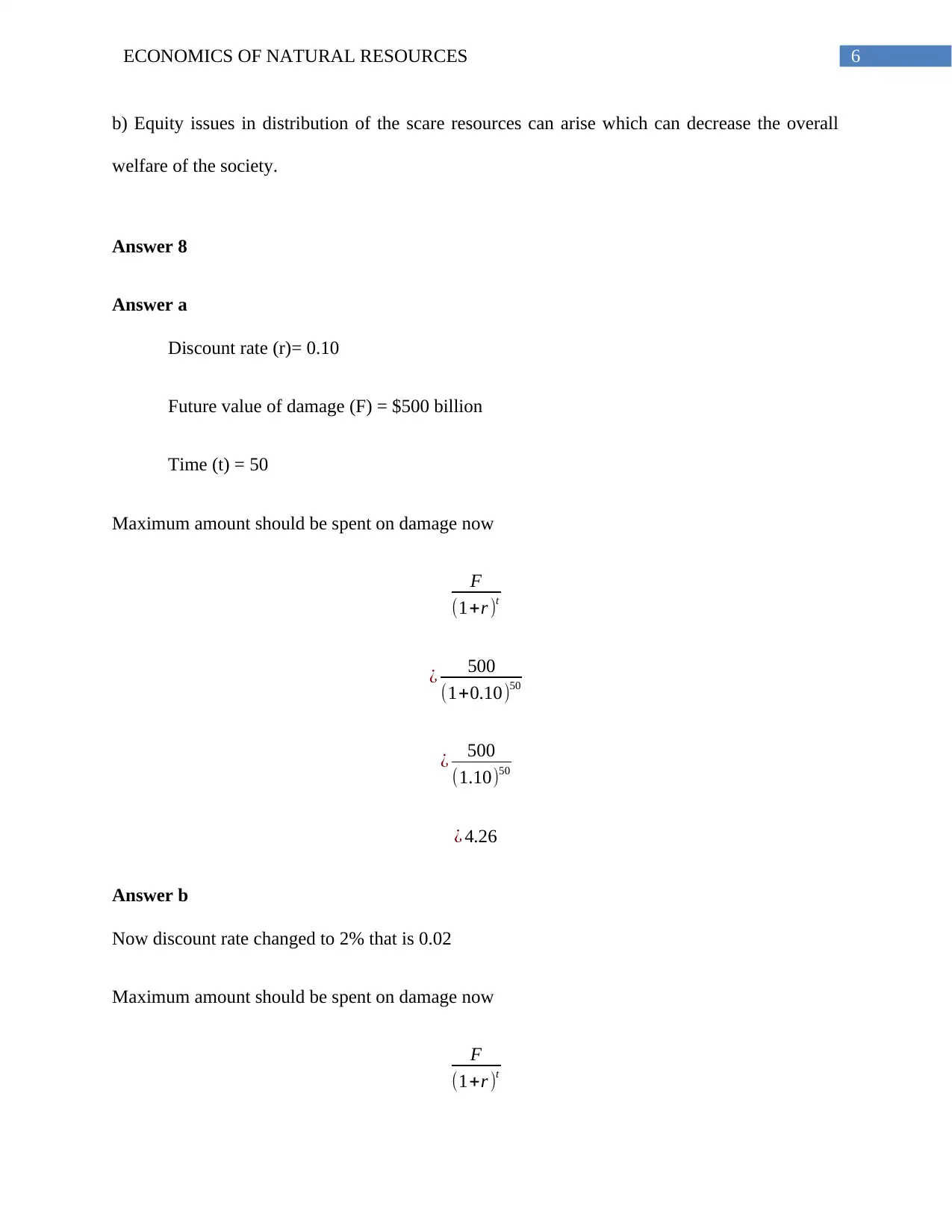
6ECONOMICS OF NATURAL RESOURCES
b) Equity issues in distribution of the scare resources can arise which can decrease the overall
welfare of the society.
Answer 8
Answer a
Discount rate (r)= 0.10
Future value of damage (F) = $500 billion
Time (t) = 50
Maximum amount should be spent on damage now
F
(1+r )t
¿ 500
(1+0.10)50
¿ 500
(1.10)50
¿ 4.26
Answer b
Now discount rate changed to 2% that is 0.02
Maximum amount should be spent on damage now
F
(1+r )t
b) Equity issues in distribution of the scare resources can arise which can decrease the overall
welfare of the society.
Answer 8
Answer a
Discount rate (r)= 0.10
Future value of damage (F) = $500 billion
Time (t) = 50
Maximum amount should be spent on damage now
F
(1+r )t
¿ 500
(1+0.10)50
¿ 500
(1.10)50
¿ 4.26
Answer b
Now discount rate changed to 2% that is 0.02
Maximum amount should be spent on damage now
F
(1+r )t
Paraphrase This Document
Need a fresh take? Get an instant paraphrase of this document with our AI Paraphraser
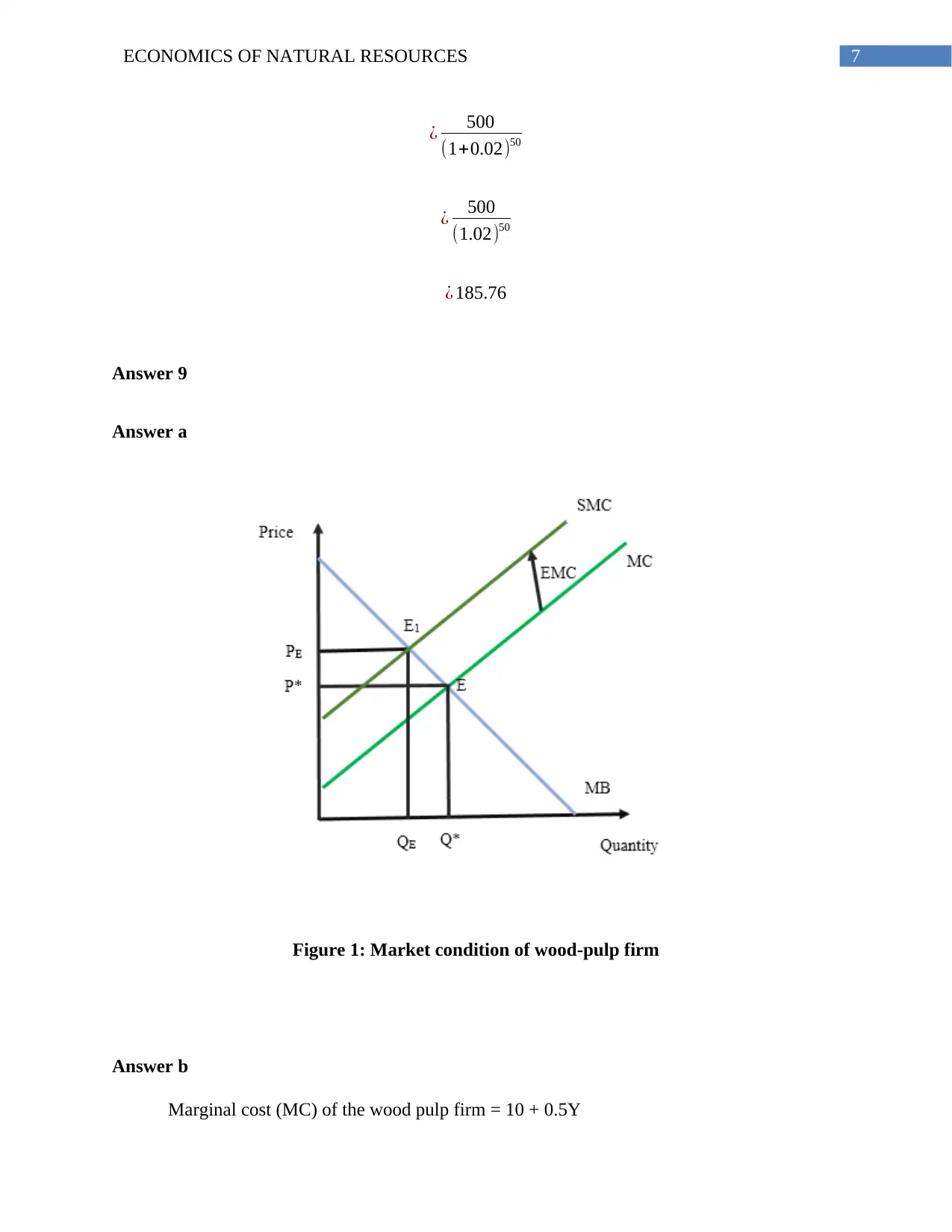
7ECONOMICS OF NATURAL RESOURCES
¿ 500
(1+0.02)50
¿ 500
(1.02)50
¿ 185.76
Answer 9
Answer a
Figure 1: Market condition of wood-pulp firm
Answer b
Marginal cost (MC) of the wood pulp firm = 10 + 0.5Y
¿ 500
(1+0.02)50
¿ 500
(1.02)50
¿ 185.76
Answer 9
Answer a
Figure 1: Market condition of wood-pulp firm
Answer b
Marginal cost (MC) of the wood pulp firm = 10 + 0.5Y
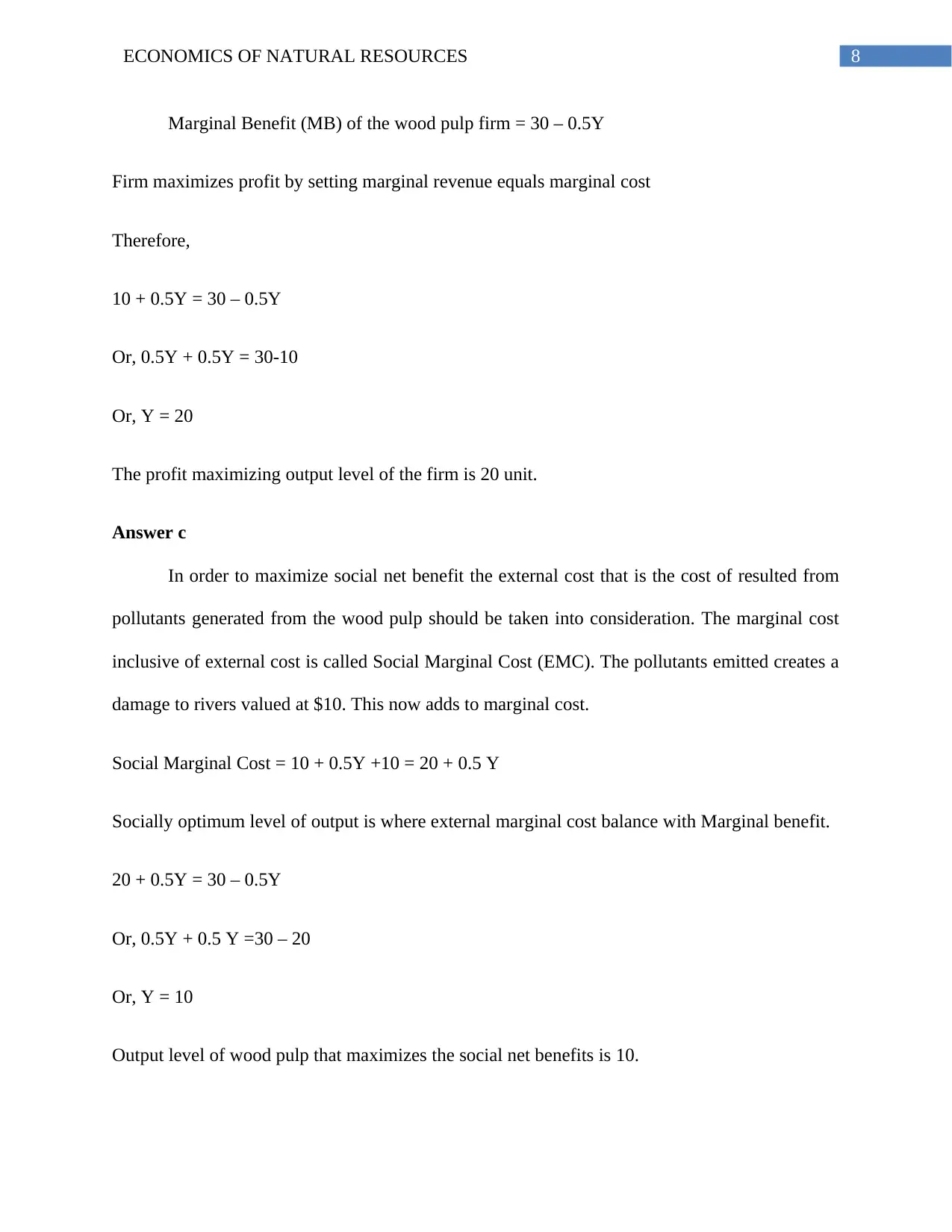
8ECONOMICS OF NATURAL RESOURCES
Marginal Benefit (MB) of the wood pulp firm = 30 – 0.5Y
Firm maximizes profit by setting marginal revenue equals marginal cost
Therefore,
10 + 0.5Y = 30 – 0.5Y
Or, 0.5Y + 0.5Y = 30-10
Or, Y = 20
The profit maximizing output level of the firm is 20 unit.
Answer c
In order to maximize social net benefit the external cost that is the cost of resulted from
pollutants generated from the wood pulp should be taken into consideration. The marginal cost
inclusive of external cost is called Social Marginal Cost (EMC). The pollutants emitted creates a
damage to rivers valued at $10. This now adds to marginal cost.
Social Marginal Cost = 10 + 0.5Y +10 = 20 + 0.5 Y
Socially optimum level of output is where external marginal cost balance with Marginal benefit.
20 + 0.5Y = 30 – 0.5Y
Or, 0.5Y + 0.5 Y =30 – 20
Or, Y = 10
Output level of wood pulp that maximizes the social net benefits is 10.
Marginal Benefit (MB) of the wood pulp firm = 30 – 0.5Y
Firm maximizes profit by setting marginal revenue equals marginal cost
Therefore,
10 + 0.5Y = 30 – 0.5Y
Or, 0.5Y + 0.5Y = 30-10
Or, Y = 20
The profit maximizing output level of the firm is 20 unit.
Answer c
In order to maximize social net benefit the external cost that is the cost of resulted from
pollutants generated from the wood pulp should be taken into consideration. The marginal cost
inclusive of external cost is called Social Marginal Cost (EMC). The pollutants emitted creates a
damage to rivers valued at $10. This now adds to marginal cost.
Social Marginal Cost = 10 + 0.5Y +10 = 20 + 0.5 Y
Socially optimum level of output is where external marginal cost balance with Marginal benefit.
20 + 0.5Y = 30 – 0.5Y
Or, 0.5Y + 0.5 Y =30 – 20
Or, Y = 10
Output level of wood pulp that maximizes the social net benefits is 10.
⊘ This is a preview!⊘
Do you want full access?
Subscribe today to unlock all pages.

Trusted by 1+ million students worldwide
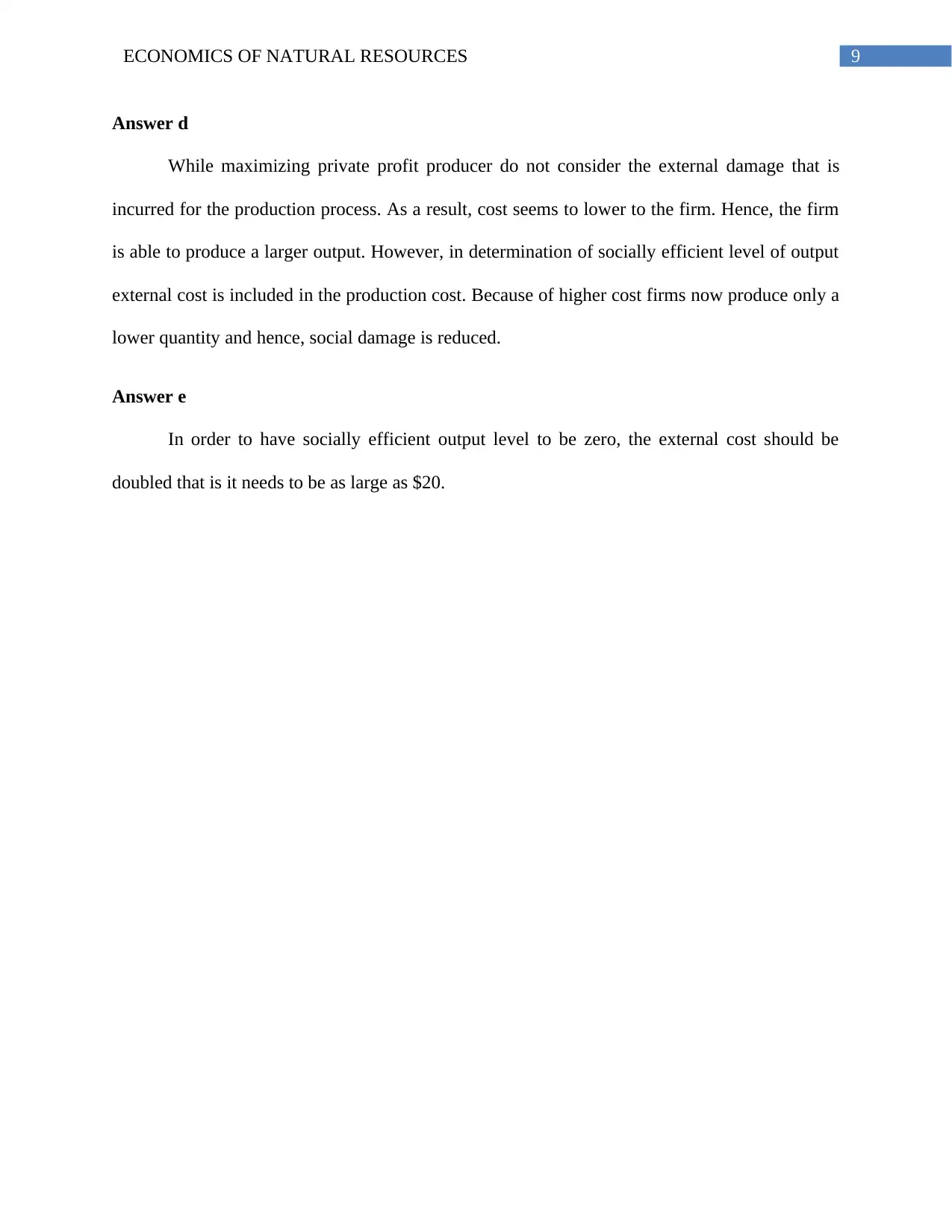
9ECONOMICS OF NATURAL RESOURCES
Answer d
While maximizing private profit producer do not consider the external damage that is
incurred for the production process. As a result, cost seems to lower to the firm. Hence, the firm
is able to produce a larger output. However, in determination of socially efficient level of output
external cost is included in the production cost. Because of higher cost firms now produce only a
lower quantity and hence, social damage is reduced.
Answer e
In order to have socially efficient output level to be zero, the external cost should be
doubled that is it needs to be as large as $20.
Answer d
While maximizing private profit producer do not consider the external damage that is
incurred for the production process. As a result, cost seems to lower to the firm. Hence, the firm
is able to produce a larger output. However, in determination of socially efficient level of output
external cost is included in the production cost. Because of higher cost firms now produce only a
lower quantity and hence, social damage is reduced.
Answer e
In order to have socially efficient output level to be zero, the external cost should be
doubled that is it needs to be as large as $20.
1 out of 10
Related Documents
Your All-in-One AI-Powered Toolkit for Academic Success.
+13062052269
info@desklib.com
Available 24*7 on WhatsApp / Email
![[object Object]](/_next/static/media/star-bottom.7253800d.svg)
Unlock your academic potential
Copyright © 2020–2025 A2Z Services. All Rights Reserved. Developed and managed by ZUCOL.





